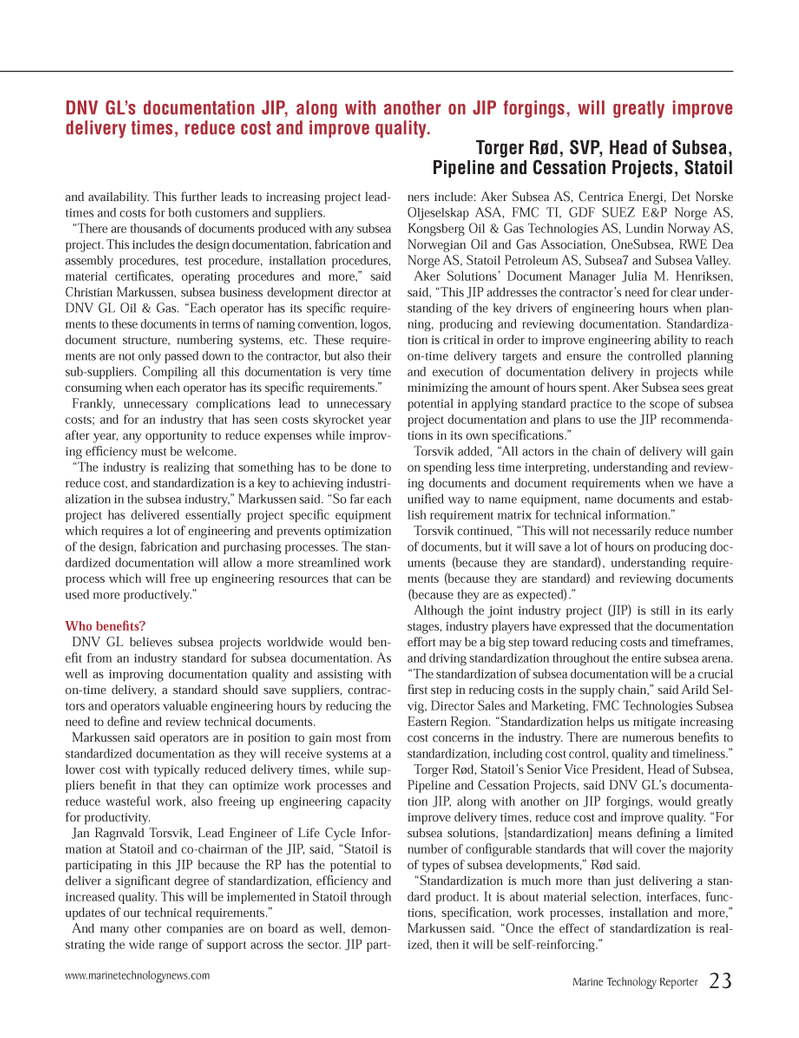
Page 23: of Marine Technology Magazine (October 2014)
Subsea Defense
Read this page in Pdf, Flash or Html5 edition of October 2014 Marine Technology Magazine
and availability. This further leads to increasing project lead- times and costs for both customers and suppliers.?There are thousands of documents produced with any subsea project. This includes the design documentation, fabrication and assembly procedures, test procedure, installation procedures, material certi cates, operating procedures and more,? said Christian Markussen, subsea business development director at DNV GL Oil & Gas. ?Each operator has its speci c require- ments to these documents in terms of naming convention, logos, document structure, numbering systems, etc. These require- ments are not only passed down to the contractor, but also their sub-suppliers. Compiling all this documentation is very time consuming when each operator has its speci c requirements.? Frankly, unnecessary complications lead to unnecessary costs; and for an industry that has seen costs skyrocket year after year, any opportunity to reduce expenses while improv- ing ef ciency must be welcome. ?The industry is realizing that something has to be done to reduce cost, and standardization is a key to achieving industri- alization in the subsea industry,? Markussen said. ?So far each project has delivered essentially project speci c equipment which requires a lot of engineering and prevents optimization of the design, fabrication and purchasing processes. The stan- dardized documentation will allow a more streamlined work process which will free up engineering resources that can be used more productively.? Who beneÞ ts?DNV GL believes subsea projects worldwide would ben- e t from an industry standard for subsea documentation. As well as improving documentation quality and assisting with on-time delivery, a standard should save suppliers, contrac- tors and operators valuable engineering hours by reducing the need to de ne and review technical documents. Markussen said operators are in position to gain most from standardized documentation as they will receive systems at a lower cost with typically reduced delivery times, while sup- pliers bene t in that they can optimize work processes and reduce wasteful work, also freeing up engineering capacity for productivity. Jan Ragnvald Torsvik, Lead Engineer of Life Cycle Infor- mation at Statoil and co-chairman of the JIP, said, ?Statoil is participating in this JIP because the RP has the potential to deliver a signi cant degree of standardization, ef ciency and increased quality. This will be implemented in Statoil through updates of our technical requirements.? And many other companies are on board as well, demon- strating the wide range of support across the sector. JIP part- ners include: Aker Subsea AS, Centrica Energi, Det Norske Oljeselskap ASA, FMC TI, GDF SUEZ E&P Norge AS, Kongsberg Oil & Gas Technologies AS, Lundin Norway AS, Norwegian Oil and Gas Association, OneSubsea, RWE Dea Norge AS, Statoil Petroleum AS, Subsea7 and Subsea Valley. Aker Solutions? Document Manager Julia M. Henriksen, said, ?This JIP addresses the contractor?s need for clear under- standing of the key drivers of engineering hours when plan- ning, producing and reviewing documentation. Standardiza- tion is critical in order to improve engineering ability to reach on-time delivery targets and ensure the controlled planning and execution of documentation delivery in projects while minimizing the amount of hours spent. Aker Subsea sees great potential in applying standard practice to the scope of subsea project documentation and plans to use the JIP recommenda-tions in its own speci cations.? Torsvik added, ?All actors in the chain of delivery will gain on spending less time interpreting, understanding and review- ing documents and document requirements when we have a uni ed way to name equipment, name documents and estab- lish requirement matrix for technical information.? Torsvik continued, ?This will not necessarily reduce number of documents, but it will save a lot of hours on producing doc- uments (because they are standard), understanding require- ments (because they are standard) and reviewing documents (because they are as expected).? Although the joint industry project (JIP) is still in its early stages, industry players have expressed that the documentation effort may be a big step toward reducing costs and timeframes, and driving standardization throughout the entire subsea arena. ?The standardization of subsea documentation will be a crucial rst step in reducing costs in the supply chain,? said Arild Sel- vig, Director Sales and Marketing, FMC Technologies Subsea Eastern Region. ?Standardization helps us mitigate increasing cost concerns in the industry. There are numerous bene ts to standardization, including cost control, quality and timeliness.? Torger Rød, Statoil?s Senior Vice President, Head of Subsea, Pipeline and Cessation Projects, said DNV GL?s documenta- tion JIP, along with another on JIP forgings, would greatly improve delivery times, reduce cost and improve quality. ?For subsea solutions, [standardization] means de ning a limited number of con gurable standards that will cover the majority of types of subsea developments,? Rød said. ?Standardization is much more than just delivering a stan- dard product. It is about material selection, interfaces, func- tions, speci cation, work processes, installation and more,? Markussen said. ?Once the effect of standardization is real- ized, then it will be self-reinforcing.? DNV GL?s documentation JIP, along with another on JIP forgings, will greatly improve delivery times, reduce cost and improve quality. Torger Rød, SVP, Head of Subsea, Pipeline and Cessation Projects, Statoilwww.marinetechnologynews.com Marine Technology Reporter 23MTR #8 (18-33).indd 23MTR #8 (18-33).indd 2310/10/2014 1:48:59 PM10/10/2014 1:48:59 PM

 22
22

 24
24
